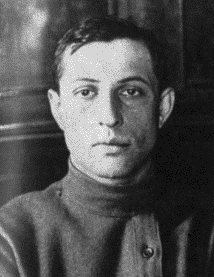Leonid Kannegiesser
Leonid Ioakimowitsch (Akimowitsch) Kannegiesser (also Kannegießer ) ( Russian Леонид Иоакимович Каннегисер * March 15 . Jul / 27. March 1896 greg. In St. Petersburg , † 1918 in Petrograd ) was a Russian poet and populist .
Life
Kannegiesser came from a Jewish family. His father, Ioakim Samuilowitsch Kannegiesser, was an engineer and managed the Black Sea shipyard in Nikolajew . The mother Rosa Lwowna Saker (1863-1946) was a doctor . The paternal grandmother Rosalija Emmanuilowna Mandelstam (1833-1905) was the sister of the ophthalmologist Max E. Mandelstamm and the literary historian Iossif Jemiljanowitsch Mandelstam . The father's cousins were the physician Alexander Gawrilowitsch Gurwitsch and the chemist Lev Gawrilowitsch Gurwitsch (1871-1926). The family lived in St. Petersburg and spent the summers in the dacha in Odessa until the beginning of the First World War .
Kannegiesser attended the private Gurevich high school in St. Petersburg . 1913–1915 he was a Junker of the Mikhail Artillery School . He then studied in the economics department of the Polytechnic Institute . He was a member of the Narodniki.
Kannegiesser belonged to the circle of Mikhail Alexejewitsch Kuzmin and to the group of young Petrograd poets with whom Sergei Alexandrowitsch Jessenin met frequently in March and April 1915. In the summer of 1915, Kannegiesser Jessenins was a guest in Konstantinowo ( Ryazan Governorate ). In Kannegiessers poems are religious themes and a ecstatic sacrifice addressed. After the February Revolution of 1917 , he wrote a poem with quotations from Esenin on Alexander Fyodorowitsch Kerensky as a bearer of hope. Kannegiesser's poems were published by his father with memories of the poet in Paris in 1928 .
In 1915, Kannegiesser had a brief relationship with the poet Pallada Olimpowna Bogdanowa-Belskaja . A closer relationship existed with the actress Olga Hildebrandt-Arbenina until 1917, when Kannegiesser's oldest brother died by accident or suicide (Olga Hildebrandt later married the writer Juri Jurkun ).
On the night of October 25th, Jul. / 7th November 1917 greg. to October 26th jul. / November 8, 1917 greg. the Junker Kannegiesser defended the Provisional Government in the Winter Palace with other Junkers .
Kannegiesser became a member of the anti- Bolshevik underground group led by his cousin Maximilian Maximilianowitsch Filonenko . Filonenko was in close contact with Boris Viktorovich Savinkov , who ordered the liquidation of Cheka boss Moissei Solomonowitsch Uritski . Kannegiesser decided to kill Uritsky after his friend Vladimir Borissowitsch Perelzweig was shot dead by the Petrograd Cheka on August 21, 1918 for a counterrevolutionary conspiracy in the Mikhail Artillery School. Kannegiesser did not know that Uritsky had tried to prevent the shooting. Shortly before the attack, he spoke to Uritsky on the phone. On August 30, around 11 a.m., Kannegiesser rode his bike to the Winter Palace and waited at the entrance to the Foreign Ministry for Uritsky, whom he shot at the elevator door in the presence of the porter. Kannegiesser escaped on his bike, ran through an open house and was quickly identified and arrested. He stated that as a Jew he killed the Jewish apostate Uritsky in order to restore the good reputation of the Jews in Russia (quoted by Arkady Iossifowitsch Waksberg ). On the same day, Fanny Kaplan carried out an assassination attempt on Lenin . During the investigation, many friends and acquaintances of Kannegiesser were interrogated and arrested. Kannegiesser was shot dead in October 1918. His parents were expelled abroad after the interrogations.
Konstantin Dmitrijewitsch Balmont wrote the poem letter K in Kannegiesser, Kaplan, Boris Kowerda and Moritz Conradi .
Kannegiesser's sister Jelisaweta was deported from Nice in 1942 and died in Auschwitz . Kannegiesser's cousin Evgenija Nikolajewna Kannegiesser (1908–1986) married the physicist Rudolf Peierls in 1931 .
Individual evidence
- ↑ a b Г. А. Морев: Из истории русской литературы 1910-х годов: к биографии Леонида Каннегисера . In: Минувшее: Исторический альманах, т. 16 . St. Petersburg 1994, p. 115–149 ( [1] accessed October 15, 2018).
- ↑ a b Николай А. Зенкович: Собрание сочинений. Т. 6. Покушения и инсценировки: От Ленина до Ельцина . ОЛМА-ПРЕСС, Moscow 2004, ISBN 5-224-02152-9 , p. 78, 115-139 .
- ↑ Поэт и смерть. Пьеса о Леониде Каннегисере (accessed October 15, 2018).
- ↑ Ярослав ЛЕОНТЬЕВ: Жили-были в канун революции трое юношей. Двое из них - совсем розовые, а третий носил такую густую черную бороду, что в его розовые, австий носил такую густую черную бороду, что в его розовые, (accessed October 15, 2018).
- ^ Roman Borissowitsch Gul. Дзержинский (начало террора) (accessed October 15, 2018).
- ↑ Mark Alexandrowitsch Aldanow : Убийство Урицкого . 1930 ( [2] accessed October 15, 2018).
- ↑ "Люба мне буква" Ка "..." (accessed October 16, 2018).
| personal data | |
|---|---|
| SURNAME | Kannegiesser, Leonid |
| ALTERNATIVE NAMES | Kannegießer, Leonid Ioakimowitsch (Akimowitsch); Каннегисер, Леонид Иоакимович (Russian) |
| BRIEF DESCRIPTION | Russian poet and narodnik |
| DATE OF BIRTH | March 27, 1896 |
| PLACE OF BIRTH | St. Petersburg |
| DATE OF DEATH | 1918 |
| Place of death | Petrograd |
